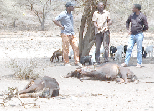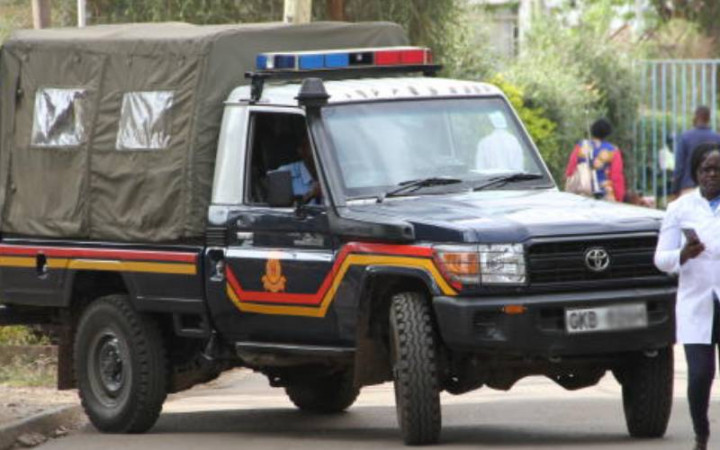Prolonged drought leaves trail of destruction in Kajiado

The catastrophic drought ravaging most parts of the country have taken a toll on Kajiado residents who have experienced long periods without rain.
Devastating drought has led to loss of livelihoods through the death of animals, disrupted learning, led to high levels of malnutrition while women have been turned to breadwinners after men left their homes for months in search for pasture.
According to the National Disaster Management Authority (NDMA), 500,000 families are facing severe starvation while a million cows have succumbed to hunger. This is an increase from 150,000 families four months ago.
The effects of drought have extended to the urban population. Lack of money to spend among pastoralists has witnessed low business. The lucrative meat business which employs hundreds of workers in urban centres has also been worst it.
Prices of cattle have sunk to the lowest in the last six months.
For instance, a mature bull that would fetch up to Sh80,000 is now retailing at Sh5,000. Chances of getting a buyer of the emaciated cattle is also a pipe dream because public health officials and vet doctors have warned against slaughtering of emaciated cattle, saying it poses serious health dangers.
Kenya Veterinary Association Senior Officer Benson Amedi says the emaciated animals have low levels of glycogen making meat go bad soon after slaughtering.
Most of the cattle being slaughtered for consumption are from far flung counties including the neighbouring countries of Uganda and Tanzania but the supply is limited. This has led to closure of major outlets, a situation that has rendered locals jobless. Meat prices have also increased amid low demand. A kilo of beef is now retailing at Sh430 while wholesale prices range from between Sh350 and Sh380.
Feeding the remaining cattle has become unsustainable. A 15kg bale of hay sells at Sh400 from Sh150 six months ago. Efforts to save their animals have sunk farmers into huge debts after taking loans to purchase hay. Some herders risk being auctioned of their land having used title deeds as collateral.
Besides the exploitive hay prices, farmers have also raised the alarm over increased cattle diseases. In some cases, the hay has turned deadly due to pesticides contamination.
Joshua Murkuku, a farmer from Isinya lost his entire herd of 30 cattle after feeding on grass along an irrigation project at Athi River.
Ameda says the increased hay caused diseases are as a result of excess pesticides used by farmers eying quick profits. “The abnormal feeding of cattle adversely affects the animals’ health. Infectious diseases and parasite infestation increase during dry seasons because transmission is faster. Herds also ingest large amounts of sand, bones and dirt which result in diseases like anthrax,” Ameda notes.
He says a move by some farmers to save their animals by grazing them in dumpsites is also dangerous as the meat is unfit for human consumption. Besides lack of water and pasture, tens of cattle died due to armyworm poisoning.
Entire herd
Jonathan Kotemu lost his entire herd of 18 cows to army worms. Samuel Topoika who served as the late George Saitoti’s body guard lost 28 cattle after they fed on army worm-infested pasture.
Hungry residents have been feeding on animal carcasses, posing a danger to their lives.
Rivers and dams which are the main source of water and boreholes have also dried up.
In rural areas the acute water shortage has witnessed water rationing where families fetch the commodity on a rotational basis.
In Magadi, residents rely on well-wishers who supply water using trucks. It has also not been easy for wildlife. Wild animals’ carcasses widespread also paint a grim picture of the drought effects in the region. Cases of human wildlife conflict have become rampant as marauding animals roam into settlements in search of water.
Maurading jumbos have turned into a threat to residents, especially those neighbouring Amboseli National Park. This has led to numerous protests and killing of jumbos by angry locals who blame Kenya Wildlife Service of being reluctant in taming the stray animals.
Moreover, the education sector bears a major brunt of the drought effects. According to the Ministry of Education transition to secondary school and Junior Secondary School has witnessed low turn-out.
The county education board now says out of the 24,000 learners who sat their KCPE last year only 15,000 have reported to Form One. Statistics by the board also indicate that only 85 per cent of Junior Secondary School learners have continued with their education. Parents who entirely depend on livestock as a source of livelihood are unable to send their children to school due to the death of their animals.
“While the government has issued a directive that all children should be in school, some parents can barely afford a meal let alone bus fare or any item needed for their children’s learning. The situation is dangerous and devastating,” says Letura.
Kenya National Union of Teachers County Secretary Elly Korinko says the low enrollment has reduced available government capitation to schools since the learners must first be listed to receive the fund. “The education sector is struggling. As stakeholders we are worried that the poor performance we have witnessed among our Kajiado schools will worsen.”
Affected girls
Some men have been away from home for months in search of water and pasture for their livestock. The affected girls have taken up donkey duties of fetching water along with their mothers in available water points, some going as far as 10kms. The few remaining emaciated donkeys can no longer carry water due to their frail health.
Cases of malnutrition among children have also been on the rise. According to nutrition county officer Ruth Lesinko, pregnant and lactating mothers have also been affected. She says two out 10 pregnant and lactating women are affected.
Cases of malnutrition are concentrated in Kajiado West, Kajiado South and Kajiado Central sub-counties. In a reversal of roles, the loss of cattle which was a source of livelihood to most families have led to an emerging trend where Maasai women have been compelled to fend for their families.
Keeping an ear on areas in which relief food would be distributed has also become a new job to them.
Agnes Resiato, a mother of seven, has now been reduced to working at an irrigation farm about 17km away from her home. She is paid Sh200 per day. “I have been a housewife all my life. I have been depending on my husband to provide for the family. All our cattle have succumbed to hunger forcing us to seek alternative means of survival,” she narrates.








